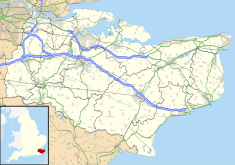Corn Exchange, Rochester
| Corn Exchange, Rochester | |
|---|---|
 Corn Exchange, Rochester | |
| Location | High Street, Rochester |
| Coordinates | 51°23′24″N 0°30′14″E / 51.3901°N 0.5038°E |
| Built | 1706 |
| Architectural style(s) | Neoclassical style |
Listed Building – Grade I | |
| Official name | Public Library (Former Corn Exchange) to rear of High Street, The Corn Exchange |
| Designated | 23 August 1974 |
| Reference no. | 1086474 |
The Corn Exchange is a commercial complex in the High Street, Rochester, Kent, England. The complex, which was commissioned as a corn exchange and is now used as an events venue, is a Grade I listed building.[1]
History[edit]
The corn exchange was commissioned by Admiral Sir Cloudesley Shovell, who was the Member of Parliament for the City of Rochester in the early 18th century.[2] It was designed in the neoclassical style, built in red brick with rusticated quoins and was completed in 1706. The design involved a symmetrical main frontage of three bays facing onto the High Street. The central bay featured a doorway with a fanlight, flanked by Doric order pilasters supporting a moulded arch with carvings in the spandrels, a frieze and a swan-necked pediment. The outer bays were fenestrated by narrow round headed windows while the first floor was fenestrated by four tall square headed windows. At roof level, there was a modillioned pediment, containing an oculus in the tympanum, a cupola containing a bell, and a weather vane.[1]
The original square-shaped projecting clock, also gifted by Shovell, was replaced by the current circular clock in 1771.[3] The author, Charles Dickens, was very impressed by the clock and described it as the "finest clock in the world".[4][5]
The original structure was never much more than a façade and it was massively extended, in the 1860s, by the construction of a new rectangular building on a site to the immediate north of the existing structure and at a right angle to it, facing onto Northgate: the new structure was designed by Flockton and Abbott, built in buff brick and completed in 1870. It was fenestrated by three tall square headed windows with architraves and keystones on the first floor and by three Diocletian windows with architraves and keystones on the second floor. Internally, the principal room was the main hall on the first floor: it featured Corinthian order columns, ornate plasterwork and elaborate chandeliers.[1] The ground floor was fitted out as a public library and opened in that use in June 1888.[6]
The use of the complex as a corn exchange declined significantly in the wake of the Great Depression of British Agriculture in the late 19th century.[7] Instead, the it became an events and concert venue and, in October 1964, performers included the band, The Who.[8] After the public library moved from the ground floor of the complex to new premises alongside the Adult Education Centre in Eastgate in 2006,[9] the Medway Register Office relocated from Maistone Road in Chatham to the ground floor of the corn exchange.[10][11] The projecting clock was restored at a cost of £40,000 in spring 2017.[12]
See also[edit]
References[edit]
- ^ a b c Historic England. "Public Library (Former Corn Exchange) to rear of High Street, The Corn Exchange (1086474)". National Heritage List for England. Retrieved 10 May 2023.
- ^ Our Own Country Descriptive, Historical, Pictorial. Vol. 5. Cassell, Petter, Gilpin and Company. 1882. p. 152.
- ^ "Rochester's famous Corn Exchange clock needs £40,000 to start ticking again". Kent Online. 26 July 2016. Retrieved 10 May 2023.
- ^ Dickins, Charles (1862). "The Uncommercial Travellor". Chapman and Hall. p. 119.
- ^ Hobbes, Robert George (1895). Reminiscences of Seventy Years' Life, Travel, and Adventure Military and Civil; Scientific and Literary. Elliot Stock. p. 95.
- ^ Greenwood, Thomas (1891). Public Libraries, a History of the Movement And A Manuel for the Organization and Management of Rate-supported Libraries. Cassell and Company. p. 513.
- ^ Fletcher, T. W. (1973). 'The Great Depression of English Agriculture 1873-1896' in British Agriculture 1875-1914. London: Methuen. p. 31. ISBN 978-1136581182.
- ^ Neill, Andrew; Kent, Matthew (2009). Anyway, Anyhow, Anywhere: The Complete Chronicle of the WHO 1958–1978. Sterling Publishing Company. p. 303. ISBN 978-1402766916.
- ^ "Acceptance of Tender: New Rochester Library". Medway Council. 13 December 2005. Retrieved 10 May 2023.
- ^ "Make your wedding a day to remember in Medway". Medway Matters. 1 June 2009. p. 9.
- ^ Turcan, Robert (2011). Rochester Through Time. Amberley Publishing. ISBN 978-1445630519.
- ^ "Historical clock above Rochester Corn Exchange will be fixed in time for the Dickens Festival". Kent Online. 21 January 2017. Retrieved 10 May 2023.

